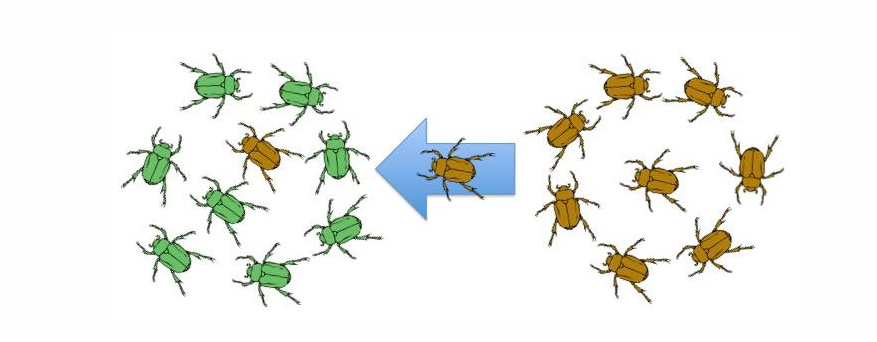evolution exam 4
1/23
There's no tags or description
Looks like no tags are added yet.
Name | Mastery | Learn | Test | Matching | Spaced |
|---|
No study sessions yet.
24 Terms
gene flow
transfer of genetic material between pops
migration, pollen, horizontal gene transfer

gene flow/migration allele frequencies
calculate initial (pre-migration) genotype/allele frequencies
calculate post migration genotype/allele frequencies based on # of migrants and their genotype frequencies
continent-island model
assume one way movement from a large population to a smaller population on an island
continent-island migration equation
frequency of A1 on island = p
frequency of A1 on continent = pm
proportion of island pop who are migrants from the continent (migration rate) = m
frequency of A1 on the island after migration = p*
p*= mpm + (1-m)p
change on island from one generation to the next
Δp = p* - p = mpm + (1-m)p-p
Δp = m(pm-p)
equilibrium
allele frequency on the island will be the same as it is on the continent
p = pm
clines
continuous change in allele frequency in space
hardy-weinberg principle
allele/genotype frequencies in a population will remain the same from one gen to gen in the absence of other evolutionary influences
gene flow homogenizing populations
gene flow includes exchange of alleles
equalization of frequencies across different populations
counteracting divergence like genetic drift and natural selection
FST , allele frequencies and variance
FST = 0 means no genetic differentiation between populations (interbreeding and share genetic material)
FST = 1 means complete genetic differentiation (pops are completely isolated, share no genetic diversity)
dispersal reasons
ephemeral (TW) habitat
get away from relatives (competition or inbreeding)
no dispersal
not possible
no suitable habitat
energetic costs
random factors in evolution
mass extinction
mutation
genetic drift
mass extinction
results from random occurrences (asteroid and volcanoes)
mutation
random process that gives rise to new alleles each generation at constant rate
adds allelic diversity; affects alleles frequencies at a given locus
genetic drift
random changes in allele frequencies or genotypes within a population due to sampling from a limited population
reduces allelic diversity; affects allele frequencies at all loci in the genome
why does a genetic drift happen?
population are not infinite, sampling error randomly changes allele frequencies

does genetic drift work better in small or larger pops?
it is faster, more efficient small pops
with more time, it can be drastic in large pops
can genetic drift fix/lose alleles
in the absence of other evolutionary forces, drift causes the eventual fixation or loss of allele
the probability that an allele will eventually go to fixation is the same as the frequency of that allele in the current pop
allele fixation probability equation
N = pop size
2N = number of alleles at locus A
x = initial number of copies of A1
what is the probability any 1 copy of these alleles will go to fixation? = 1/2N
what is the probability that allele A1 will go to fixation? = x(1/2N) = x/2N
equations for proportion of frequencies after generations
Hg+1 = Hg (1-(1/2N))
Hg+1 = expected heterozygosity in next gen
Hg = observed heterozygosity in current gen
Ht = H0 (1-(1/2N))t
effective population size (Ne)
smaller than census size
fewer individuals contribute to next generation’s genes than could